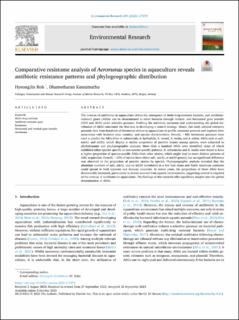| dc.description.abstract | The overuse of antibiotics in aquaculture drives the emergence of multi-drug-resistant bacteria, and antibiotic-resistant genes (ARGs) can be disseminated to other bacteria through vertical- and horizontal gene transfer (VGT and HGT) under selective pressure. Profiling the antibiotic resistome and understanding the global distribution of ARGs constitutes the first step in developing a control strategy. Hence, this study utilized extensive genomic data from hundreds of Aeromonas strains in aquaculture to profile resistome patterns and explores their association with isolation year, country, and species characteristics. Overall, ∼400 Aeromonas genomes were used to predict the ARGs from A. salmonicida, A. hydrophila, A. veronii, A. media, and A. sobria. ARGs such as sul1, tet(A), and tet(D), which display a similar proportion of positive strains among species, were subjected to phylodynamic and phylogeographic analyses. More than a hundred ARGs were identified, some of which exhibited either species-specific or non-species-specific patterns. A. salmonicida and A. media were found to have a higher proportion of species-specific ARGs than other strains, which might lead to more distinct patterns of ARG acquisition. Overall, ∼25% of strains have either sul1, tet(A), or tet(D) gene(s), but no significant difference was observed in the proportion of positive strains by species. Phylogeographic analysis revealed that the abundant numbers of sul1, tet(A), and/or tet(D) introduced in a few East Asian and North American countries could spread to both adjacent and faraway countries. In recent years, the proportions of these ARGs have dramatically increased, particularly in strains sourced from aquatic environments, suggesting control is required of the overuse of antibiotics in aquaculture. The findings of this research offer significant insights into the global dissemination of ARGs. | |
